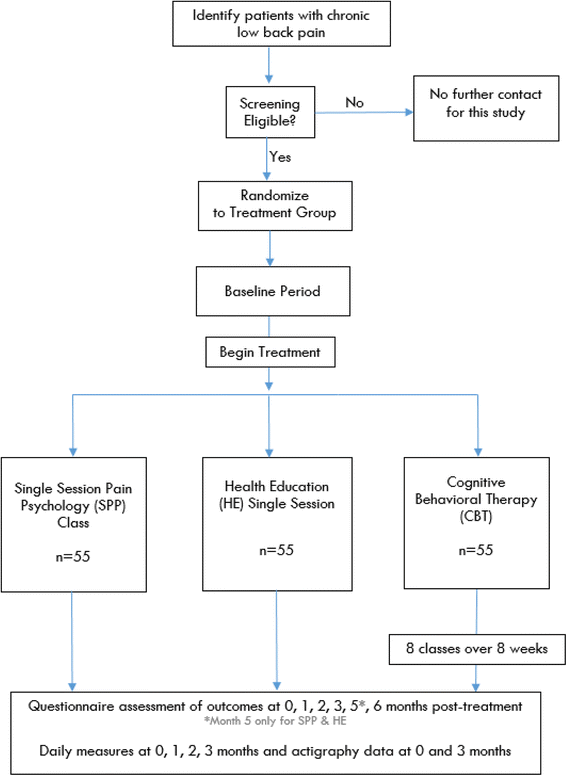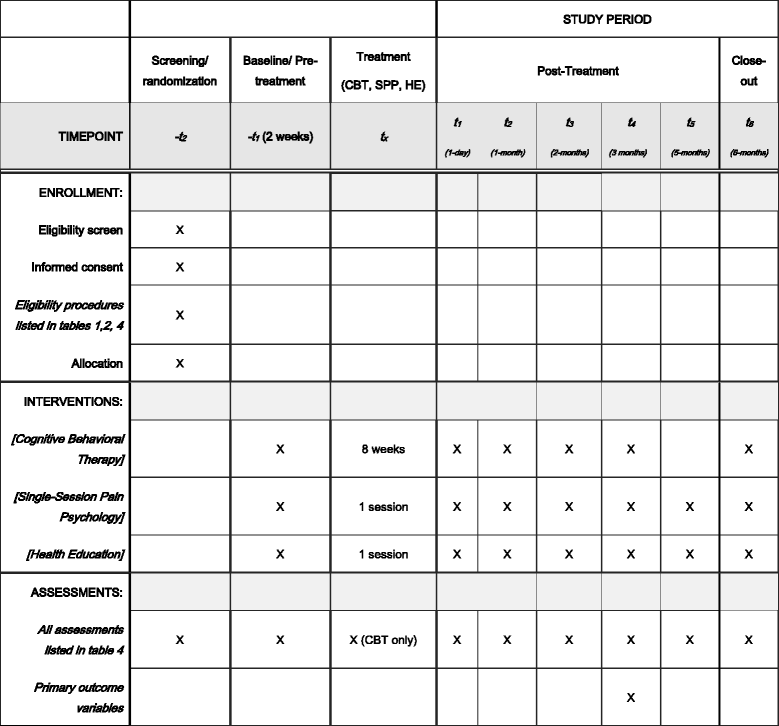Comparative Efficacy and Mechanisms of a Single-Session Pain Psychology Class in Chronic Low Back Pain: Study Protocol for a Randomized Controlled Trial
- PMID: 29510735
- PMCID: PMC5838852
- DOI: 10.1186/s13063-018-2537-3
Comparative Efficacy and Mechanisms of a Single-Session Pain Psychology Class in Chronic Low Back Pain: Study Protocol for a Randomized Controlled Trial
Abstract
Background: The Institute of Medicine (IOM) reported that chronic pain affects about 100 million U.S. adults, with chronic low back pain (CLBP) cited as the most prevalent type. Pain catastrophizing is a psychological construct shown to predict the development and trajectory of chronic pain and patient response to pain treatments. While effective treatment for pain catastrophizing typically includes eight-session groups of cognitive behavioral therapy (CBT), a single-session targeted treatment class yielded promising results which, if replicated and extended, could prove to efficiently and cost-effectively reduce pain catastrophizing. In this trial, we seek to determine the comparative efficacy of this novel single-session pain catastrophizing class to an eight-session course of pain CBT and a single-session back pain health education class. We will also explore the psychosocial mechanisms and outcomes of pain catastrophizing treatment.
Methods: In this trial we will randomize 231 individuals with CLBP to one of three treatment arms: (1) pain-CBT (eight weekly 2-h group sessions with home exercises and readings); (2) a single 2-h pain catastrophizing class; or (3) a single 2-h back pain health education class (active control). For the primary outcome of pain catastrophizing, the trial is designed as a non-inferiority test between pain-CBT and the single-session pain catastrophizing class, and as a superiority test between the single-session pain catastrophizing class and the health education class. Team researchers masked to treatment assignment will assess outcomes up to six months post treatment.
Discussion: If the single-session targeted pain catastrophizing class is found to be an effective treatment for patients with CLBP, this low cost and low burden treatment could dismantle many of the current barriers and burdens of effective pain care. Further, elucidation of the mechanisms of pain catastrophizing treatments will facilitate future research on the topic as well as further development and refinement of treatments.
Trial registration: ClinicalTrials.gov, NCT03167086 . Registered on 22 May 2017.
Keywords: Back pain; Chronic pain; Cognitive behavioral therapy; Pain catastrophizing; Psychology; Treatment.
Conflict of interest statement
Ethics approval and consent to participate
The study was approved by Stanford’s Institutional Review Board (protocol no. 34631), 3000 El-Camino Real, Five Palo Alto Square, 4th Floor, Palo Alto, CA 94306, USA. We are obtaining informed consent from all participants in the study.
Consent for publication
Not applicable.
Competing interests
The authors declare that they have no competing interests.
Publisher’s Note
Springer Nature remains neutral with regard to jurisdictional claims in published maps and institutional affiliations.
Figures
Similar articles
-
Efficacy and mechanisms of a single-session behavioral medicine class among patients with chronic pain taking prescription opioids: study protocol for a randomized controlled trial.Trials. 2020 Jun 12;21(1):521. doi: 10.1186/s13063-020-04415-x. Trials. 2020. PMID: 32532346 Free PMC article.
-
Comparison of a Single-Session Pain Management Skills Intervention With a Single-Session Health Education Intervention and 8 Sessions of Cognitive Behavioral Therapy in Adults With Chronic Low Back Pain: A Randomized Clinical Trial.JAMA Netw Open. 2021 Aug 2;4(8):e2113401. doi: 10.1001/jamanetworkopen.2021.13401. JAMA Netw Open. 2021. PMID: 34398206 Free PMC article. Clinical Trial.
-
Central mechanisms of real and sham electroacupuncture in the treatment of chronic low back pain: study protocol for a randomized, placebo-controlled clinical trial.Trials. 2018 Dec 13;19(1):685. doi: 10.1186/s13063-018-3044-2. Trials. 2018. PMID: 30541586 Free PMC article.
-
Combining manual therapy with pain neuroscience education in the treatment of chronic low back pain: A narrative review of the literature.Physiother Theory Pract. 2016 Jul;32(5):408-14. doi: 10.1080/09593985.2016.1194663. Epub 2016 Jun 30. Physiother Theory Pract. 2016. PMID: 27362980 Review.
-
Domains of Chronic Low Back Pain and Assessing Treatment Effectiveness: A Clinical Perspective.Pain Pract. 2020 Feb;20(2):211-225. doi: 10.1111/papr.12846. Epub 2019 Nov 11. Pain Pract. 2020. PMID: 31610090 Review.
Cited by
-
Efficacy of a Single-Session "Empowered Relief" Zoom-Delivered Group Intervention for Chronic Pain: Randomized Controlled Trial Conducted During the COVID-19 Pandemic.J Med Internet Res. 2021 Sep 10;23(9):e29672. doi: 10.2196/29672. J Med Internet Res. 2021. PMID: 34505832 Free PMC article. Clinical Trial.
-
Mindfulness-Based Stress Reduction, Cognitive Behavioral Therapy, and Acupuncture in Chronic Low Back Pain: Protocol for Two Linked Randomized Controlled Trials.JMIR Res Protoc. 2022 Sep 27;11(9):e37823. doi: 10.2196/37823. JMIR Res Protoc. 2022. PMID: 36166279 Free PMC article.
-
"My Surgical Success": Effect of a Digital Behavioral Pain Medicine Intervention on Time to Opioid Cessation After Breast Cancer Surgery-A Pilot Randomized Controlled Clinical Trial.Pain Med. 2019 Nov 1;20(11):2228-2237. doi: 10.1093/pm/pnz094. Pain Med. 2019. PMID: 31087093 Free PMC article. Clinical Trial.
-
An Open Trial of a Mind-Body Intervention for Young Women with Moderate to Severe Primary Dysmenorrhea.Pain Med. 2020 Nov 7;21(7):1385-1392. doi: 10.1093/pm/pnz378. Pain Med. 2020. PMID: 32022890 Free PMC article. Clinical Trial.
-
"Pain, Stress, and Emotions": Uncontrolled trial of a single-session, telehealth, emotional awareness and expression therapy class for patients with chronic pain.Front Pain Res (Lausanne). 2022 Nov 18;3:1028561. doi: 10.3389/fpain.2022.1028561. eCollection 2022. Front Pain Res (Lausanne). 2022. PMID: 36466215 Free PMC article.
References
-
- Simon LS. Relieving pain in America: A blueprint for transforming prevention, care, education, and research. J Pain Palliat Care Pharmacother. 2012;26:197–198. doi: 10.3109/15360288.2012.678473. - DOI
-
- Sullivan MJ, Bishop SR, Pivik J. The pain catastrophizing scale: development and validation. Psychol Assess. 1995;7:524. doi: 10.1037/1040-3590.7.4.524. - DOI
Publication types
MeSH terms
Associated data
Grants and funding
LinkOut - more resources
Full Text Sources
Other Literature Sources
Medical



